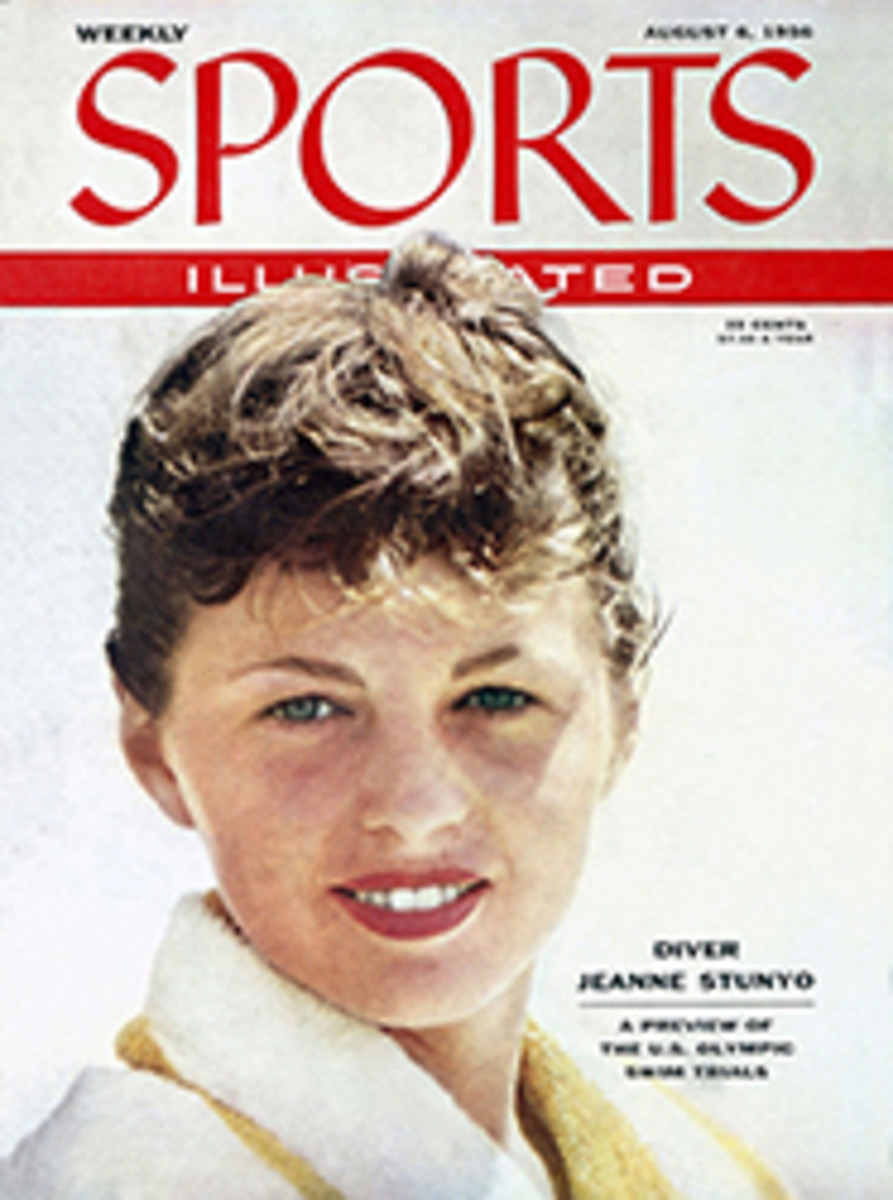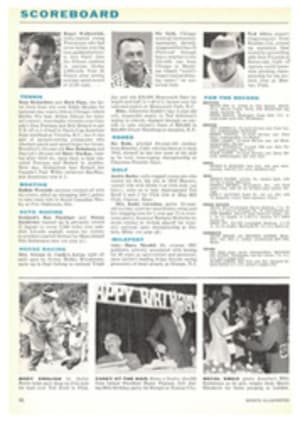
SCOTCH HIGHBALL
LE MANS, FRANCE
There was a hard, bitter, cold rain whipping across western France. Around Le Mans's 8.36-mile track, where the famed 24-hour Grand Prix of Endurance has excited automobile fans almost every peacetime year since 1923, a drenched crowd watched eagerly as mechanics pushed 49 sports cars into starting positions.
High up in the press box, French Reporter Olivier Merlin looked down on the scene and philosophized, "There's a reassuring thing about the world of sport. Life always takes its revenge on death."
That summed up the odd sensation of being back at Le Mans. On a similar Saturday afternoon little more than a year ago, from the same vantage point, I saw Pierre Levegh's Mercedes erupt in a sheet of flame and flying metal that killed 83 spectators. Now there are two reminders of the catastrophe: a black marble plaque engraved with a cross and the date of the disaster, and a refurbished track.
Last year's tragedy had been a one-in-a-million fluke. There had been plenty of thrills and spills but relatively few deaths in Le Mans history. In 16 races before the war, only three drivers were killed. Since competition was resumed in 1949 and until last year, three more fatal accidents occurred on the lopsided rectangle.
But decades of good fortune were washed away in blood last year. At first, French officials were paralyzed. Then, after months of study, they borrowed 300 million francs and set to work. They widened critical roadway, created a long "deceleration zone" into renovated pits, built signal stations out on the course and beefed up barriers for spectator protection. More important, they altered the rules. Drastic new fuel consumption regulations were effected and, to reduce spiraling speeds, prototype cars over 2.5 liters piston displacement were eliminated. This, in effect, made Britain's 3.5-liter D Jaguars heavy favorites, since they were the only first-rate big-engined make able to squeak into the production category. Gone were the big Italian cars.
But there was still an imposing array, headed by three factory and two private D Jaguars and extending down in size to tiny DBs and Stanguellinis.
For the big cars, the big worry was gas consumption. Britain's Stirling Moss was concerned about his thirsty Aston-Martin, and Jean Behra, a Talbot driver, was frankly perplexed. He shrugged, "In a race you drive fast, and when you drive fast you burn gasoline. But how can you burn gasoline you don't have?"
In practice, last year's winner, Mike Hawthorn, drove a fuel-injection factory D Jaguar to the fastest lap time of more than 114 mph and confirmed the Jags' favorite status.
Just about the only person in the pits on race day who was taking it calmly was a Pickwickian gentleman never before seen at Le Mans: Scotsman David Murray. Portly in blue coveralls, with a few wisps of white hair peeking out beneath his tartan tarn, Murray had brought his own private D Jag to race. "We're not here to win," he promised. "We just want to see what it's like."
A whisky exporter and ex-driver, Murray had made a resounding success of a private racing stable, the Ecurie Ecosse. With him to Le Mans he brought his partner Wilkie Wilkinson, three mechanics, Drivers Ninian Sanderson and Ron Flockhart and a metallic-blue Jaguar.
Compared to big European manufacturers spending millions on racing, Murray and Wilkinson were shoestring artisans, although they begged off talking about profits, saying, "Internal revenue may be listening in."
By race time Wilkinson had spent hundreds of hours manicuring the car, including a 12th-hour dismantling and reassembly.
As the traditional 4 p.m. starting time approached, spectators stood in the rain for five national anthems and a silent moment of prayer for last year's dead. The silence continued as the seconds ticked off, and suddenly, at a signal, the drivers sprinted to their cars, gunned the motors and pulled away.
The unbanked asphalt highway was slick with wetness and treacherously awaiting victims. Barely 10 minutes after the start, the first crash came. Coming down to the S-turns Jaguar's Paul Frere spun into a parapet. Teammate Jack Fairman braked hard and was slammed by the Marquis de Portago's Ferrari. All three limped off course, but to Louis Héry, a 43-year-old Nantes garage owner coming along in a Panhard, one abandoned car looked too close. Héry tried braking, spun and his car burst into flames. Héry died in a hospital.
With two factory Jags out and the Hawthorn car suffering from faulty plugs, David Murray's car eased into first place. The Stirling Moss-Peter Collins Aston-Martin took the lead away, but lost it in the seventh hour. Lap after lap the two cars went round and round with the regularity of a bagpipe rhythm.
Within the first hour seven cars were out of the race, and after 12 hours 27 machines had quit. The track looked like an automotive graveyard.
Jaguar and Aston-Martin battled furiously through the night and into the cold, wet, cheerless dawn. As Wilkinson warmed up with a few nips of Scotland's principal export, the Scottish Jaguar gradually drew away from its smaller competitor and by the 23rd hour was a lap ahead. "Anything can happen," Wilkinson cautioned.
But nothing did. As the crowd screamed wildly for the winner, Flock-hart brought the car slowly across the finish line.
Only 14 cars were running at the finish. Of the record 35 machines which quit, 13 suffered accidents, two were ruled out for breaking the gasoline rule and the rest faded with mechanical failures. The winner's average speed of 104.40 mph was the slowest since 1952, but the customer had beat the factory and Wilkinson was ecstatic.
"It's not believable," he shouted. "It's not believable."
[originallink:10470011:41947]
PHOTO
SCOTCH-OWNED D JAGUAR, THE EVENTUAL WINNER, LEADS ASTON-MARTIN AFTER FIRST LAP

